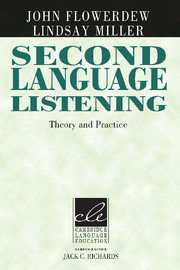Appendix: Concluding Questions for Reflection
Published online by Cambridge University Press: 04 February 2010
Summary
In this section, we suggest a list of essay and project titles and topics. The reader may wish to consider these as “tests” of their knowledge on teaching and developing listening skills. If this book has been used as a core text, the instructor may consider setting some of the essays or projects as part of the course assessment.
Essays
Write a 3,000-word essay on one of the following topics:
Explain how different approaches to language learning have affected the ways in which listening has been taught in the classroom. Give your views on the effectiveness of each method.
How do the various features of speech affect how we teach listening?
How do language objectives and learning objectives differ? Illustrate how they can be combined in a listening task.
Critique the eight dimensions for listening (Chapter 6) and show, with examples, how they can be incorporated into a listening task.
Discuss the effectiveness of technology in the classroom as an aid to teaching listening.
Projects and Presentations
Prepare and present a project on listening based on one of the following ideas:
Choose a general textbook and critically examine a selection of listening tasks in the book. Select at least two tasks each from the beginning, middle, and end of the book. Prepare additional exercises to accompany the tasks so as to enhance learners' listening skills.
Use the guideline questions about the dimensions of listening in Chapter 6 to prepare five listening activities for a group of learners of your choice.
- Type
- Chapter
- Information
- Second Language ListeningTheory and Practice, pp. 211 - 212Publisher: Cambridge University PressPrint publication year: 2005



